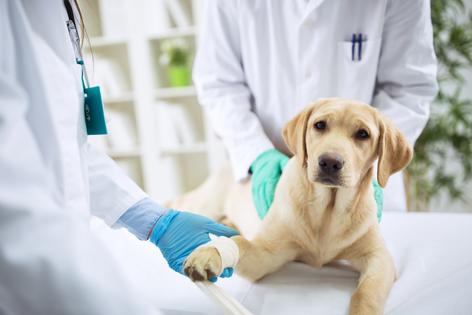My Pet World: A dog’s personality changes after surgery
Dear Cathy,
Patrick is a 90-pound, three-year-old, lab mix rescue. He was born without hip sockets and had two surgeries to remove the ball on top of his femur so that he could live a normal life. The surgeries were done four months apart, beginning when he was about a year old. He had physical therapy for several months after each surgery and is doing well. He is a very sweet and loving dog that lives with us and two other lab mixes — eight and 11 years old. All three dogs get along fine.
When Patrick was a puppy, before his surgeries, we took him for walks, and nothing bothered him. Now every unusual sound he hears while outside scares him, and he runs for the door to get inside. We have a fenced yard, and all three have the run of the yard when out there. I think something must have scared him while he was recovering after surgery at the vet's office; maybe a table with metal instruments or bowls fell while he was in recovery. We feel bad for him. We tried a Thundershirt®, but it did not help. I hope you can provide some ideas.
— Ken, Granby, Connecticut
Dear Ken,
While there's no way to know how he developed this fear, I have seen dogs develop fears and phobias after surgeries and unexpected illnesses or injuries. As a result, they can be a little more hesitant and reactive to their surroundings. You can help your dog in two ways: provide reassurance and build his confidence.
Reassurance includes using a Thundershirts® or Anxiety Wrap®, an over-the-counter anxiety chew, or a pheromone collar to reduce his anxiety. Confidence is built through accomplishments. Increase his training beyond basic obedience and consider something like rally obedience, so he learns it's okay to have new experiences. Rally obedience involves walking your dog through a course with signs that give instructions on the next skill to be performed. You can check out rally obedience skills online and create your own backyard course.
Finally, every dog should be trained to relax. When you see him in a relaxed pose or when he stays relaxed after hearing a new sound, say his unique marker word (i.e., bingo) to mark the desired behavior and give him a treat. (Each dog should have their own training word.) You usually have to combine several strategies over time before seeing results.
Dear Cathy,
I have two six-year-old parakeets, male and female. For the last three years, the female has laid eggs but doesn't sit on them. That's not the problem. The problem is the cuttlebone that I put in their cage. I've had parakeets in the past where it took them about a month before they finished it. The parakeets that I have now finish it in one day. During the pandemic, it was so hard to find cuttlebone, and it is still hard. I can't keep replacing it every day. Is there anything that can replace a cuttlebone, or is it okay for them not to have it all the time?
— Lisa, Flushing, New York
Dear Lisa,
It's okay for them not to have a cuddle bone all the time, but only if their diet provides for all their nutritional needs. Cuttlebones are calcium supplements, so their behavior could indicate a calcium deficiency. Dr. Robert Groskin, the executive director for the Association of Avian Veterinarians, also says there could be parasites in their beaks or the female could be craving calcium because she is about to lay eggs. An avian veterinarian should review your birds’ diet to determine deficiencies and make dietary recommendations that will meet all their nutritional needs.
Another thing to consider is that bored birds can become obsessive about certain things. If it turns out to be behavioral, you will need to provide additional stimulation. Place their cage near a window (but not in the sun), so they can look outside. Rotate their toys. Give them opportunities to forage for food. There are forage toys out there, but you can just put their daily food in tiny, separate bowls, so they have to go to every bowl to get their daily meal. You also can cover the bowls with small piece of paper, so they have to remove them to eat.
Training also can reduce boredom. Training a parakeet is like training any other pet — repetition, marking the desired behavior (with a clicker), and rewarding the correct behavior. You can train your birds to sit on your finger, talk, and do some simple tricks.
========
(Cathy M. Rosenthal is a longtime animal advocate, author, columnist and pet expert who has more than 25 years in the animal welfare field. Send your pet questions, stories and tips to cathy@petpundit.com. Please include your name, city, and state. You can follow her @cathymrosenthal.)
©2022 Tribune Content Agency, LLC.
(c) 2022 DISTRIBUTED BY TRIBUNE MEDIA SERVICES, INC.












Comments